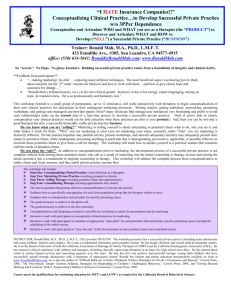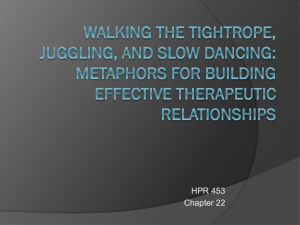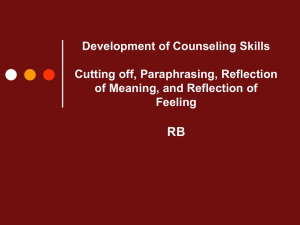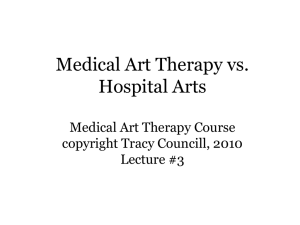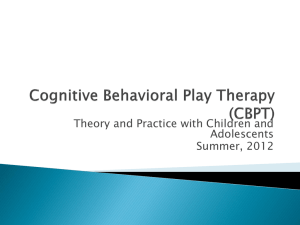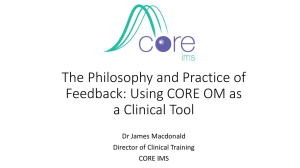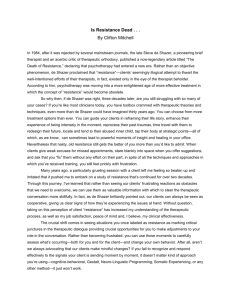Case conceptualization and the therapeutic stance
advertisement
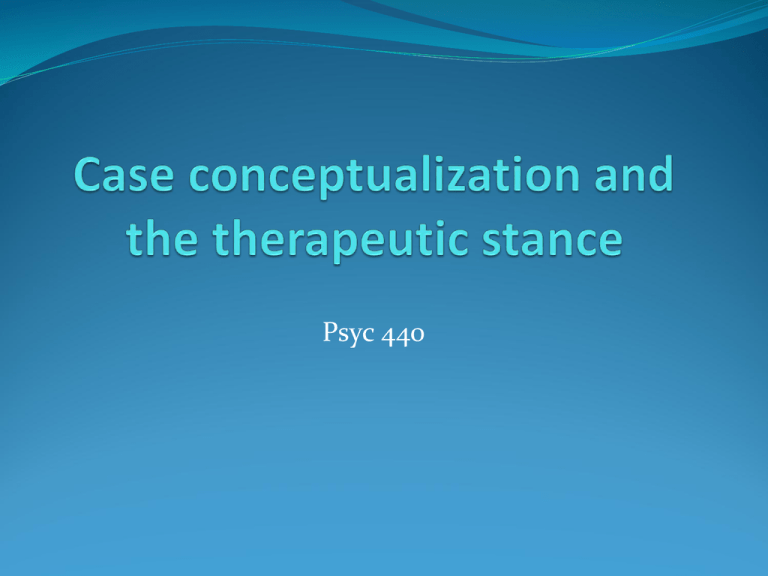
Psyc 440 Case conceptualization What is a case conceptualization? Any ideas? Case Conceptualization Many psychological treatments are only used with one specific disorder i.e. depression, anxiety etc. In ACT, the assumption is that the six core processes can be used to explain and treat any psychological disorder i.e. it is trans-diagnostic From this perspective, case conceptualization involves applying the six core processes of ACT to each client and then using this understanding to guide the selection and evaluation of treatment interventions In essence, an ACT approach to case conceptualization seeks to answer the following question; What unique factors in this clients life have given rise to his or her particular problems and led to this clients particular version of life constriction and psychological inflexibility How to conduct a case conceptualization Begin the process with the presenting problem, as understood by the client 2. Discover the most central thoughts, feelings, memories, sensations and situations the client is fused with or avoiding 3. Consider behaviors that function as experiential avoidance of the events described in the previous step 4. Consider domains in which behavior is excessively narrowed or constricted, or in which living is avoided altogether 1. 5. Consider other core ACT processes that contribute to 6. 7. 8. 9. 10. psychological inflexibility and their treatment implications Consider factors that can limit motivation for change Consider the clients social and physical environment and its influence on the clients ability to change Examine client strengths that could be harnessed to build psychological flexibility Describe a comprehensive treatment plan Re-evaluate the conceptualization through treatment; revise functional analysis, targets and interventions Case conceptualization in practise Now I want you to move through each of the 10 steps with a practise case. Sandra Read the information then fill in the case conceptualization form The therapeutic stance Decades of research has shown that the therapeutic relationship is consistently correlated with clinical outcome, for virtually all types of therapy (Martin, Graske & Davi, 2000) Importantly however, knowing the therapeutic relationship is crucial does not tell us how to produce good therapeutic relationships Indeed attempts to train therapists to build effective alliances have so far produced insignificant findings (CritsChristoph et al, 2006) Therapeutic stance in ACT The ACT model provides clear suggestions about how to improve the therapeutic relationship Although some supportive data exists (Gifford et al, under review) at this point these inferences are made on the basis of the theory underlying ACT Essentially the job of therapist is to maintain a stance that instigates and reinforces psychological flexibility Over the next few pages we will outline some of these basic but flexible rules 1. The ACT therapist speaks to the client from an equal, vulnerable, compassionate, genuine, and sharing point of view, and respects the clients inherent ability to move from unworkable to workable responses 2. The therapist is willing to self disclose about personal issues when it serves the interest of the client 3. The therapist avoids the use of canned ACT interventions, instead fitting interventions to the particular needs of the client. The therapist is ready to change course to fit those needs at any moment 4. The therapist tailors interventions and develops new metaphors/experiential exercises/behavioral tasks to fit the clients experience and language practices, and the social, ethnic and cultural context 5. The therapist models acceptance of challenging content while also being willing to hold the clients difficult ideas, feelings and memories without any need to resolve them 6. The therapist always brings the issue back to what the clients experience is showing, and does not substitute his or her opinions for that genuine experience 7. The therapist does not argue with, lecture, coerce, or attempt to convince the client The importance of self-ACT In order to better serve the clients needs ACT therapists also apply the model to themselves This happens in two forms Firstly, they apply the model to their everyday lives Secondly, they apply the model during the therapy session The second point is very important, as during the therapy process it is important, as a clinician, to catch the times when you are avoidant, fused or out of contact with the present moment and distant from ones valued directions Lets think of a few examples when the core ACT processes would be helpful for the therapist Many ACT therapists attend workshops and read ACT based self help books (Mindfulness for two, Wilson and DuFrene, 2010) to apply the model to their own lives. Certain ACT therapists also go to therapy themselves. The importance of the relationship One of the main aims of therapy is to generalise the advances made in the therapy room to the outside world The therapeutic relationship can be a great tool in achieving this Namely, because many clients manifest the problems they have in relationships with other people, in the therapy room, with the therapist The affords the therapist the opportunity to work on these issues first hand, in the service of broader generalization to the outside world This relationship can also be used as an assessment i.e. if a client is reporting greater willingness to have social anxiety, but anxiety in the therapy room is avoided, then something is probably wrong! Let look at the video!




